Stags Singing in the Rain
August 20, 2020



 Hunting,SCA Articles
Hunting,SCA Articles
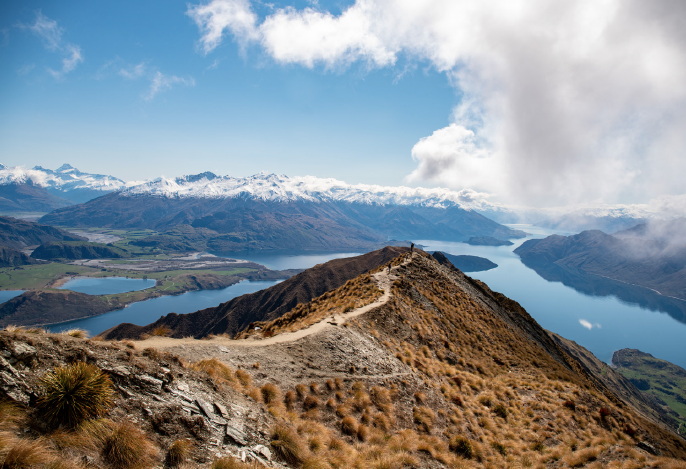
There we were. Not lying atop rocks. Not huddled under dank, dripping nylon, wishing we’d brought more than instant coffee and a few packs of freeze-dried forage.
No, we were sitting, dry and cozy, sipping a fine New Zealand pinot noir and eating piping hot red stag tenderloin while watching a March rain drip from the apartment balcony, the Southern Alps rising dramatically behind beautiful Lake Wanaka.
“A toast!” I proposed. My happy wife lifted her glass, beaming at me or the scenery or the effects of the wine. Maybe all three.
“Toasting what?” she asked.
“To New Zealand, the Southern Alps, red stags, the far-sighted Englishmen who imported them — and especially, to John Scurr for importing us!”
John Scurr had invited us to his homeland for crass commercial purposes: he wanted us to alert you to the titillating possibilities of touring the magical isle of New Zealand. With an emphasis on hunting.
After decades of managing a sheep ranch, a red deer ranch and an outfitting business, John has “retired” to dabble in custom tours. You tell him what you’d like to do in New Zealand, and he’ll make it happen, all the while narrating the history and behind-the-scenes details that only a bred-and-born, fourth-generation local could.
 “See that big ridge,” he asked as he drove us up the snaking two-lane highway from Queenstown to Wanaka. “I used to ride over that to muster sheep. We’d scour all that country for a couple of days to drive everything down, camping as necessary. Of course, I always had my .22 for shooting rabbits. That was one of my important jobs from age seven on.”
“See that big ridge,” he asked as he drove us up the snaking two-lane highway from Queenstown to Wanaka. “I used to ride over that to muster sheep. We’d scour all that country for a couple of days to drive everything down, camping as necessary. Of course, I always had my .22 for shooting rabbits. That was one of my important jobs from age seven on.”
Having misspent his youth and much of his adult life in too many rough, hungry hunting camps around the world, Scurr now appreciates the more genteel accommodations that appeal to non-hunting spouses as well as veteran hunters.
“With world-class stags, bull tahr, fallow deer and chamois within an hour or two of good food and lodging, why suffer?” he’d half joked while selling Betsy and me on his services at last year’s SCI confab in Reno.
“Seriously, we can get you into as tough a hunt as you want without having to rough it. Coffee shops. Museums. Boating. Biking. Rafting. If that appeals to you.”
“Oh, it appeals!” Betsy chimed in. And I knew we were onto something good.
“We find that our clients— especially their wives—rather like the more civilized amenities. Nice restaurants, a bottle or two of good New Zealand wine…”
“Zip lines and bungee jumping too?” I asked.
“We customize to your interests. Something for everyone, right?”
Oddly, New Zealand didn’t always have something for everyone. Historically, the mammalian taxonomy extended to fur seals and one bat species, which hardly comports with today’s menagerie.
In the minds of hunters, New Zealand and overly endowed red stags are as inseparable today as New Zealand and kiwi. But while the several species of flightless, nocturnal kiwi are native to this strange island, red stags and human hunters are not.
Nature, as is her wont, produced on New Zealand many species of flightless birds. The giant moa was so flightless that it didn’t even possess vestigial wings. And then Nature, as is also her wont, enabled a tool-making hominid to sail to this bird paradise. In little more than a hundred years the moa was no more. By 1400 A.D. the Maori, not understanding sustainable use or extinction, had killed and eaten the last of the ostrich-like birds.
Into this vacuum came other adventurers, mostly Englishmen. Abel Tasman sailed within sight of New Zealand in 1642, but it wasn’t until British explorer James Cook mapped the coast in 1769 that European migration began trickling in, bringing with it a voracious herbivore that would surely have exterminated any moa the Maori had missed. Sheep. The woolies quickly converted the wild hunting grounds of the Maori into a pastoralist’s paradise. But for some Englishmen, sheep weren’t good enough. These sportsmen wanted something more wild than wooly. They wanted an animal with grace, wits and the will to preserve both. Large antlers wouldn’t hurt, either.
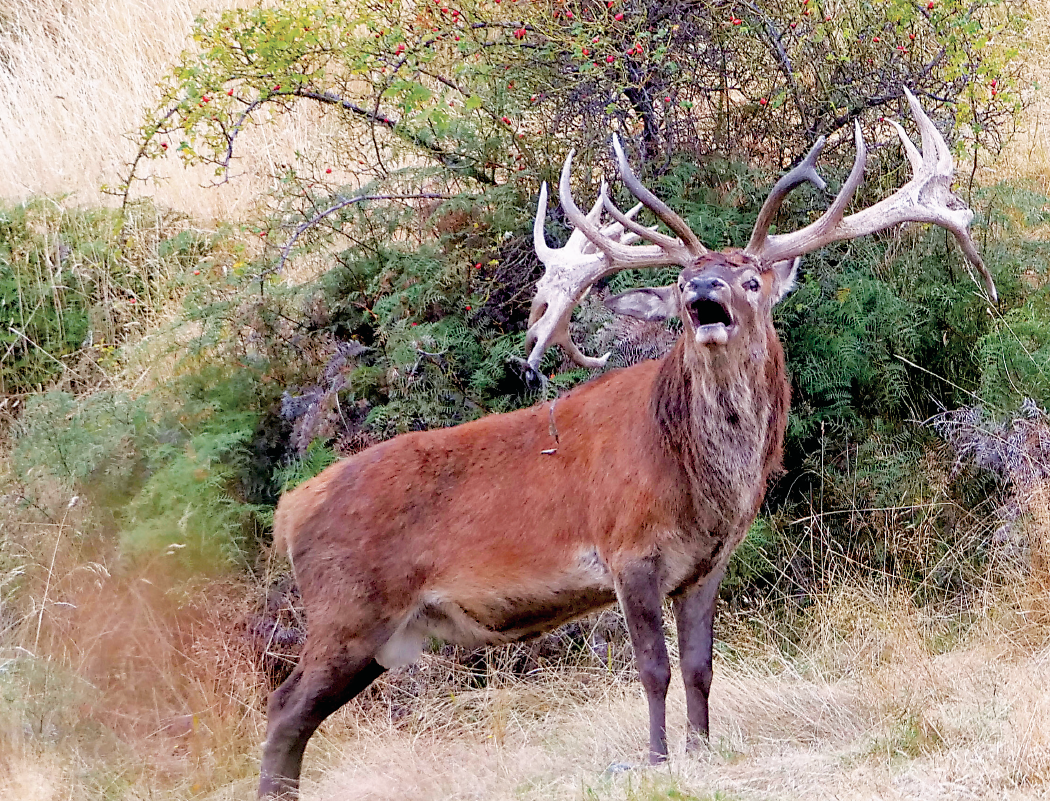
They introduced red deer. Good bloodlines from various estates in England. By the 1920s, deer stalking was a major tourist attraction. By the 1930s, red deer were so abundant that seasons and bag limits were forgotten. Between 1932 and 1954, an estimated three million red deer were killed by government cullers. And still the deer persisted. Helicopter culling got underway in the 1960s. The large and sudden supply of venison created a meat market that inspired deer farming in the 1970s. John Scurr was an early adopter.
“I understood the hunter’s passion as well as the rancher’s interest in commodity production,” Scurr explained. “If we could raise sheep, why not deer? Mutton and wool. Venison and velvet antlers. And, if you owned the deer and kept them on your property, the government had no more right to exterminate them than your sheep.”
Just as ranchers selectively breed sheep for desired genetics, so they bred red deer, importing superior genetics from such famous English herds as Warnham Park and Woburn Abbey. And thus evolved, quickly, the famous, giant-antlered stags of New Zealand. Antlers scoring an astonishing 400 SCI inches popped up. Then 500 inches, 600 inches and higher. There are reportedly stags today laboring under more than 800 inches of antler.
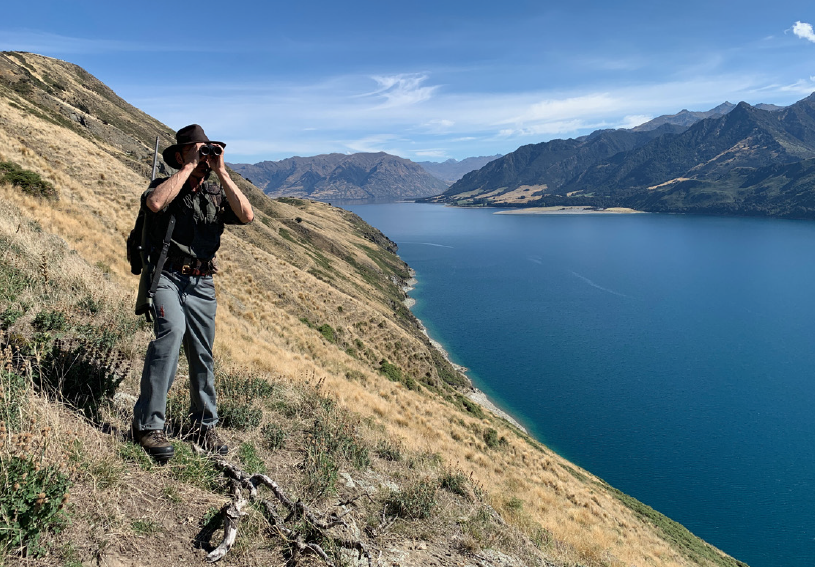 The World of Deer museum near Wanaka illustrates this in fascinating detail. Curator Clive Jermy is delightfully articulate and a veritable encyclopedia of red deer history. After an hour with Clive, you’re ready to hunt the nearby hills.
The World of Deer museum near Wanaka illustrates this in fascinating detail. Curator Clive Jermy is delightfully articulate and a veritable encyclopedia of red deer history. After an hour with Clive, you’re ready to hunt the nearby hills.
“There’s one roaring in the valley just over this ridge.” Scurr’s cousin, Grant Scurr, was leaning through the truck window, dripping. He’d crawled reconnaissance in the rain while we sat in the truck waiting for a break. Break time over.
Grant’s stag was standing under a manuka tree, soaking up the liquid sunshine, chocolate brown antlers glistening. It raised its snout, opened its mouth and roared. It was the opening refrain of an elk bugle without the whistle at the end. It ignited an antiphony of competing roars. Stags singing in the rain.
We spent the next two hours trying to see the right one. Too young. Too big for my checkbook. Too wary. We ducked. Crawled through manuka thickets, thorny rose bushes, dense stands of bracken. One stag, possibly the model for Landseer’s Monarch of the Glen, posed atop a ridge, surveying his domain. We climbed, crawled and maneuvered, but could find no cover to take us closer than 500 yards. The stag sneered and stepped over the ridge.
This wasn’t exactly the way we imagine an “estate” hunt is supposed to play out. Enclosed stags are supposed to be fish in a barrel. But these were very wary fish in a 15,000-hectare barrel. That’s roughly 30,000 football fields or 45 square miles. And that’s not counting the ups and downs. Most was up and down. You’d run out of the roaring season before you could hunt half this area. And we had but a few days.
On one of those days we tried a relaxing boat hunt, gliding up vast glacial lake Hawea by the light of a full moon. Shortly after sunrise we were glassing vertical shores. If we were lucky, we might drop a stag, buck or bull right from the boat. At worst, we’d have a short stalk. This was going to be a walk in the park.
Turned into a scramble in the bramble. There was more brush than first appeared. The horned and antlered game we sought knew how to hide within it. I spotted a hind and calf saunter over a high ridge. Six hours, two miles and 2,000 feet later, we were right behind them.
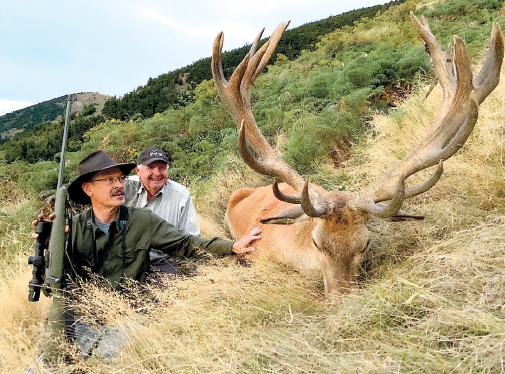
Grant crawled to the rim, peeked, crawled back. No red deer. But tahr rams. A pair feeding just under the lip. We bellied over, rifle ready. I gave Grant my rangefinder and instructed him to range the target bull. The Sig BDX would relay the distance to my scope and illuminate the correct holdover aiming point. It was so easy it was almost cheating.
Before the two bulls fed into the open, I spied a dozen ewes and kids on a far slope. The rangefinder indicated 565 yards. An amber dot lit up far down the vertical reticle. For population control, I’d been asked to shoot at least one female tahr, but it would have to wait until the bull was down.
“Bulls coming out of that draw,” I whispered to Grant. “Midway to the ewes. Three. No, four. Now five.”
“Some good ones. Older than the two under us,” Grant said. “Let’s try to sort one out.”
Just then a sixth bull stepped out of the brush.
“That’s the one. Just 365 yards. You good with that?”
I was, but they were coming closer. At 325 yards, I shot. The bullet sounded loudly. The bull dived into the brushy draw and didn’t come out. Grant ranged the ewes.
“The one on the ledge is 545 yards.” I steadied the 6.5 Creedmoor on my pack, put the blue dot on the shoulder and sent a sleek, 142-grain AccuBond Long Range bullet on its arcing trajectory. It made the trip in about a half-second, knocking the ewe off the ledge.
After photos, Grant and apprentice guide Ed Braco insisted Betsy and I accompany Grant’s 14-year-old son, George, off the mountain while they handled the skinning and extraction. I started to protest, but then considered the grandmother of my grandkids beside me. Betsy is tough as they come, but this slope’s angle of repose was as sharp as a cow’s face at a water trough. And so were the rose thorns one was tempted to grab during the slippery descent. And we’d be bushwhacking the whole way. It took an hour, the last bit maneuvering through a bog by flashlight.
Betsy got even the next afternoon. After a fruitless search for my stag, Grant spotted three good fallow bucks working their way deeper into the manuka ravines. We hurried to intercept, but while pausing on a climb to catch our breath, I spotted wide, moose-like antlers flicker through some branches across the draw. A dark fallow buck. Betsy set my rifle atop the shooting sticks.
“A hundred twenty-three yards. Dead on hold low on the shoulder. Stay ready,” I whispered.
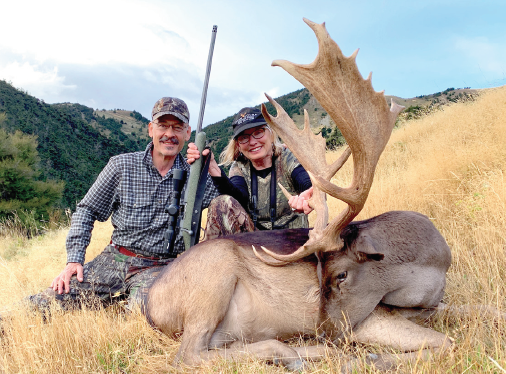
An hour later the buck broke cover. I grunted. It stopped. Betsy fired. Our little rifle was now three for three. But trouble comes in threes and we hadn’t got a stag yet.
The country around our headquarters, Wanaka, is stunningly scenic, rivaling the best of Alaska and British Columbia. Alas, gravity is the same, too. John drove us high when he could, then we trudged, climbed, slipped and climbed some more. During the mid-day lulls, we enjoyed coffee shops and quaint restaurants (Florence’s Cafe our favorite—two desserts, please) and historic sites such as the Cardrona Hotel, 19th century gold rush towns and scenic road trips. We got educated at the deer museum and laughed at the monument to Shrek, the champion wool-producing sheep sheared on an iceberg. We scratched our heads at the Bra Fence and its unique genesis after a millennial party. (Scurr can tell you all about it. He was there!) We could have tried fishing, rafting and scenic flights to glaciers, but we saved all that for after the hunt.
Evenings we were free to dine at local restaurants or cook and relax in our own apartment. Nice break from the usual social lodge scene.
Of course, not getting a stag was only temporary. I was dragging things out to enjoy the rut phenomena. Bulls roaring and moving, never quite exposing a vital spot. Some hiding and slipping away unseen. One broke from cover so fast that it plunged into a brushy draw between us and disappeared before I could shoot.
We were trudging back to the trucks one dusk after a day of near misses, actually beginning to wonder if we might fail. I’d stopped to photograph a manuka flower, so Ed had to rush back and hiss for me to come with the rifle. There in the gloaming stood a Goldilocks stag. Just right. But when I popped into view, it rushed up the mountain. I got on him.
Grant stage-whispered: “one hundred eighty-seven” when it stopped to look back.
I steadied the blue reticle on the shoulder, low, and broke it with the tough little .264 bullet. One and done and somewhat unhappy to be so. But tenderloins were yet to come and there was Milford Sound, Te Anau Lake, the southernmost tip of the island, Bluff oysters, seal and penguin rookeries, beaches…And John Scurr knew them all.
